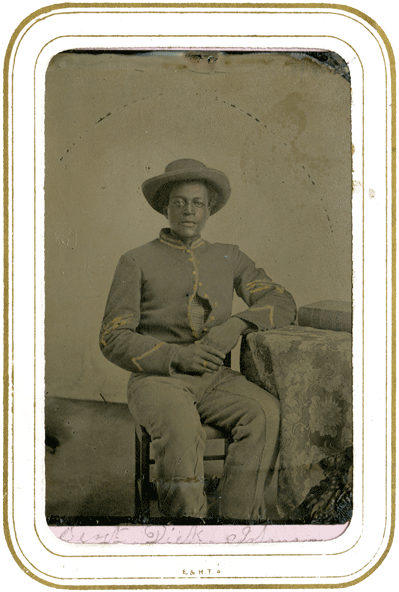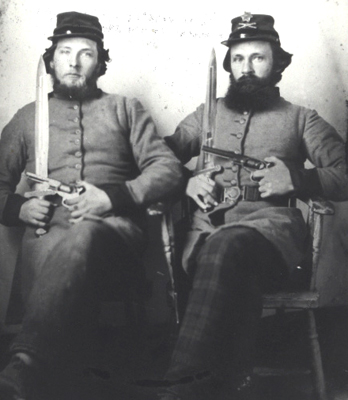
| Home | Introduction | Glossary | Bibliography |
Introduction

In 1995 I asked the Director of Programs for the Tennessee Wars Commission, Fred Prouty, how many fights took place in Tennessee during the Civil War. He referred me to Paul E. Long’s Book, The Civil War Day by Day, which gave the number one thousand four hundred sixty two. Curiosity was aroused when it was discovered that there was no indication as to just how the sum was calculated. While it provides lists, Frederick H. Dyer’s venerated Compendium of the War of the Rebellion supplies neither totals not citations to impart finality or authority to his inventory. Apparently no one had questioned this glaring methodological deficit in the nearly century-old work. Long, likewise, makes available not a whit of information about the aggregate he presents. Even more surprising was the discovery that the Official Records (OR) did not address the question. The only thing to do was to try to duplicate the numbers as found in Dyers’ Compendium and Long’s work. The results were perplexing. Long’s unsubstantiated claim of one thousand four hundred sixty two engagements was two hundred five short from the total found by counting of Dyer’s Compendium’s likewise unsupported list, which came to one thousand six hundred sixty seven. An initial corresponding count of citation in the OR two-volume Index gave a total of one thousand one hundred sixty nine, or four hundred less than Dyer and two hundred ninety three fewer than Long. It was necessary meticulously to consult the OR index and count and count again, eleven times, until a list of over one thousand seven hundred was settled upon. Even this number cannot be held to be final because the kinds of events defy definition; even the Reference Department of the U. S. Military Academy library could provide no help in classifying such nineteenth-century terms such as “action,” “engagement,” “affair,” or “skirmish.” Additionally, entries under the heading “skirmish” may have read “skirmishes,” usually with no indication as to how many skirmishes took place. It is anyone’s guess how many more incidents were never recorded. In any event, the new list was not just bigger, but more importantly, documented with primary sources.
At this point the project evolved into an extensive effort of transcribing official reports and creating an accompanying chronological register of combat events. The intent was to come up with a more nearly accurate list of combat events dates while adding a narrative element. This was a daunting task, and as it progressed narrative portions for each entry formed a weighty manuscript. Research in period newspapers, letters and journals expanded the topical range beyond military subjects. Some of these included public health issues in the cities, juvenile delinquency, politics, illegal cotton trading, inflation, commodities’ speculation, charity, refugees and the role of women. A historical marker was erected as a result of information that established the scene of the first fight in Tennessee, the “affair” at Travisville, September 29, 1861. As a result of research the girth of the manuscript expanded to well over three thousand six hundred pages. This led to considerations about producing a narrated, accredited presentation, a sourcebook for the Civil War in Tennessee. It became evident ink-and-paper publication opportunities were at best limited.
A more cost effective way to deliver this information would be through an electronic means, such as a compact disc and/or a web site. A grant was awarded by the National Park Service/American Battlefield Protection Program, matched by the Tennessee Historical Commission and Tennessee Wars Commission, to fund the production of a limited number of disks and a web site, created by Mark Johnson in Houston, Texas, which was launched on January 1, 2006. A copy of each disk was sent to every public and private secondary school library, public and collegiate library, while the web site is universally available.
The sourcebook is the result of an earnest historical audit. If it is not perfectly inclusive it is thoroughly documented, an attribute earlier studies failed to exhibit. It is tempting to believe that this sourcebook is comprehensive, but it can only claim to be “more nearly complete,” or possibly “extensive in its scope.” As an online sourcebook it is an innovative mechanism for learning about the conflict in Tennessee, one that offers the reader only primary source information about the struggle in the Volunteer State and its impact on its people.
Ambitions for this sourcebook are to reduce the time and effort required for both professionals and dilettantes to conduct primary research into the Civil War in the Volunteer State. This in turn may provide a positive historical research experience for those who otherwise might not have the time to investigate and study due to circumstances of training or inconvenience. It is expected to be of use in local tourism development efforts, particularly in view of the state’s having been designated by Congress as the nation’s only Civil War National Heritage Area. This documentary sourcebook can be one means to expand Civil War tourism as well as adding verisimilitude to the visitor’s experience. It also can be considered a source for some absorbing narrative reading. After each document transcript there is a brief citation, to the right, indicating the source from which the entry was taken. Citations provide verification and demonstrate the professionalism going into the work.

This sourcebook can help direct attention from a narrow fixation on combat to a healthier appreciation of the complexity of the war in Tennessee. It can assist local historians, school teachers, planners and archaeologists in their search for locations for Civil War history events in their neighborhoods. It may serve as source matter for historical roadside markers. It can serve an educational function by offering an alternative to what might be called a Civil War legacy mind set. This traditionally interprets the war as an experience shared essentially by white males. Yet it touched the lives of literally millions of people, whether soldiers or civilians, men, women or children. While there is much that is compelling, highlighting only what is charismatic has led to discounting much of the rest in the past. In part this sourcebook aims to promote an appreciation of a many faceted history. A good way this ambition could be advanced is by making the primary sources in this collection readily available to the public. This will introduce otherwise arcane or difficult to obtain information and expand knowledge about the conflict. Moreover, this sourcebook offers a means to better understand the history behind heritage experiences and battlefield preservation efforts which can only be positive consequences for Tennessee's designation as Americas only national Civil War heritage area. As Harry S. Truman said: “The only thing new in the world is the history you don't know.”
For many the same question that sparked the production of this sourcebook “how many fights took place in Tennessee during the Civil War” is of primary interest. Before attempting to quantify the answer it must be stated that it is difficult to distinguish between types of denominations of combat. That is, the differences between and “engagement” and an “affair,” or an “expedition” and a “reconnaissance” is unknown. Even the reference desk at the United States Military Academy at West Point could not assist in determining definitions of nineteenth-century military nomenclature. Nevertheless, the findings below try to answer that question and reveal what is a more nearly correct accounting of kinds of military incidents in Civil War Tennessee. This list is an original presentation and shows that skirmishes, numbering one thousand two hunded fifty five, account for 39% of total combat events, while battles account for .04%. As a result of this work Tennessee’s total is put at three thousand two hundred forty five combat incidents, exceeding Long’s tally by one thousand seven hundred eighty three. As may be seen, greater weight has been given to the smaller kinds of combat action than to big battles. This is in part because the famous battles fought in Civil War Tennessee have been examined in detail by many historians and to duplicate those efforts here would be, at best, gilding the lily. In addition it helps direct the focus of this sourcebook to the common soldier. This is best epitomized in an excerpt from an April 1863 Confederate newspaper article on the Army of Tennessee which identifies the ordinary casualty and his usual level of combat:
The wounded are supported away on horseback; so is the limber man, whose placid face proves that he died very suddenly. After a while a widow weeps somewhere, but the world never hears anything about it—it was only “a skirmish up at the front.” And so of lesser skirmishes, where small scouting parties meet. Many of the noblest and bravest spirits of this war have thus fallen; but no halo of battle glory brightens their names—they fell “skirmishing up at the front.”

It isn’t entirely a story of how they died in the war - in fact, far more died of disease than combat wounds - it is also a story of how they lived in the war, both civilian and soldier, in the country and in the cities. Life was adversely affected, but it went on nonetheless, an aspect of the war often not described in the majority of books about the conflict in the Volunteer State. We already know how the war turned out, but the people swept up in it had to wait over four years to learn its outcome. This sourcebook is unique in that it also undertakes to address the civilian side of the Civil War as well as the martial and to provide a sense of the chaos and confusion that are among the off spring of war.
One further note may be advisable: Some readers might not be aware that spelling in the nineteenth century was not as uniform as it is today. It is sometimes considered best, when confronted with an unusual spelling, to use the literary device “[sic],” Latin meaning “thus; so.“ It is used to indicate that a quoted passage, especially one containing an error or unconventional spelling, has been retained in its original form or it was when incorrectly inscribed by the writer. This expedient has not been used in this sourcebook because of the number of documents and the great number of improper spellings. Its use was considered too cumbersome and so all misspellings found in the documents present in the sourcebook [other than any incorrectly made by the editor] are as they were found in the original text. The reader will recognize how annoying the use of “[sic]” would have been when understanding that there are not quite three million words in this work. Nevertheless, any errors readers may discover will be thankfully corrected upon receipt of notification.
James B. Jones, Jr.
Public Historian
Tennessee Historical Commission
2941 Lebanon Road
Nashville, TN 37214
(615)-532-1550 x115
(615)-532-1549 FAX